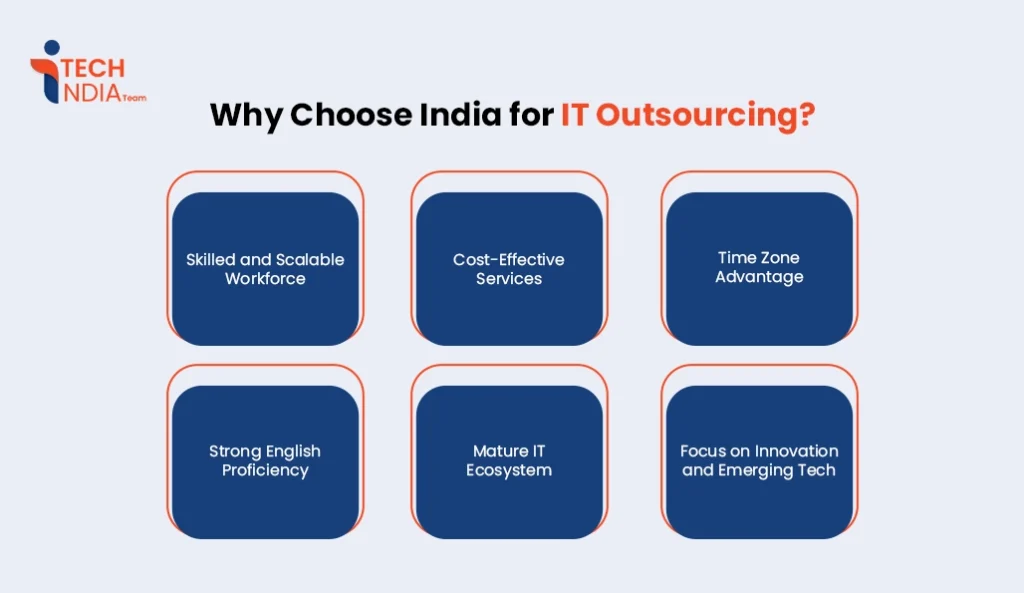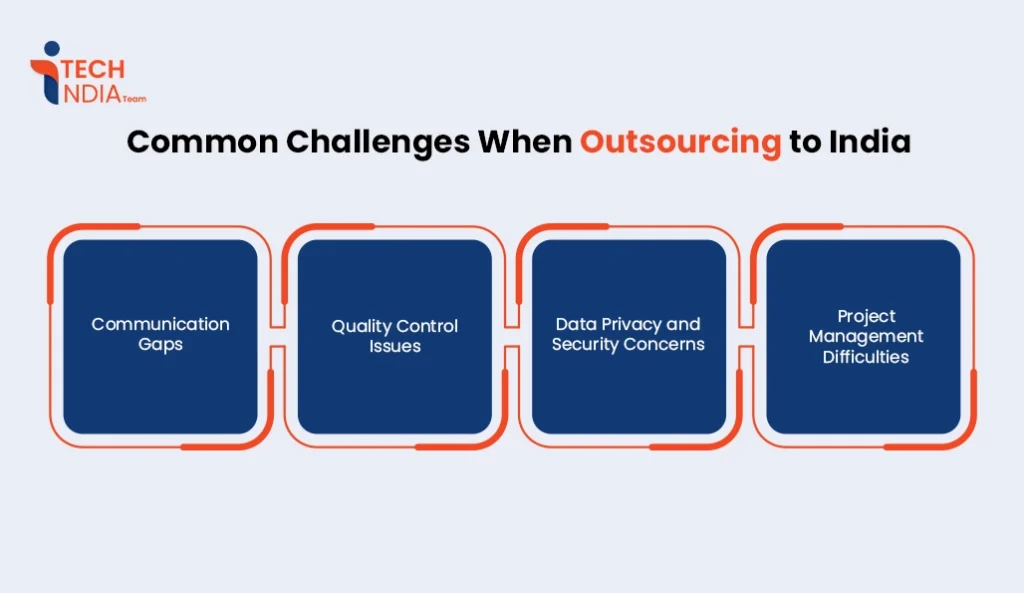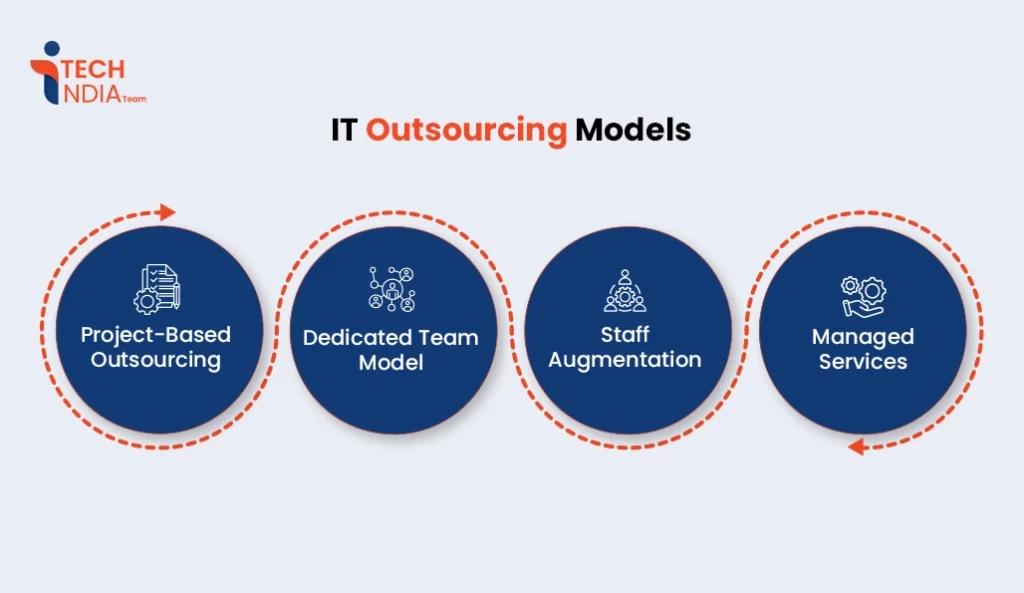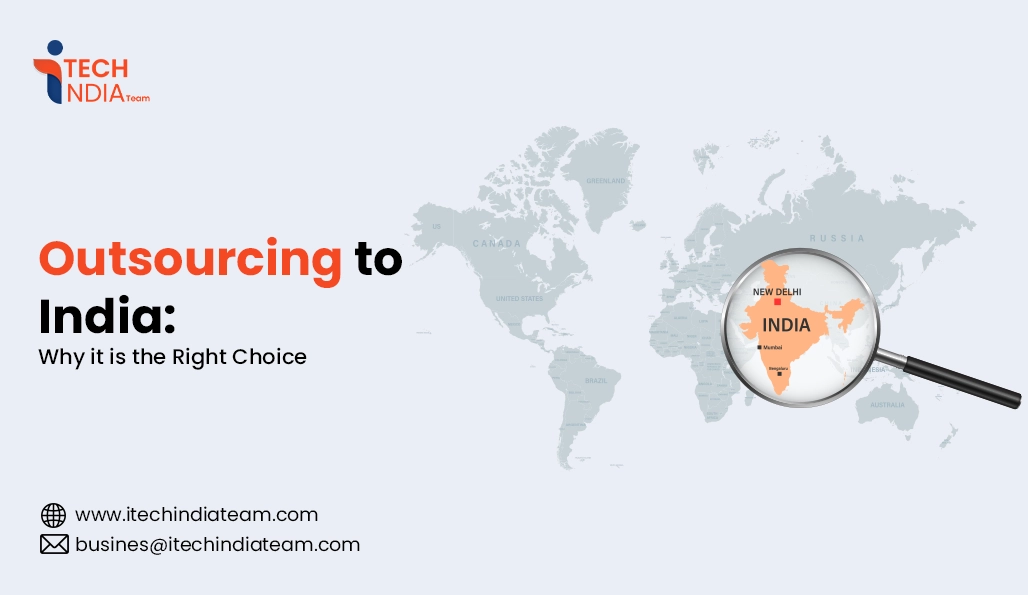Outsourcing to India: Why it is the Right Choice
Picture this: You’re under pressure with deadlines, seeking to scale your business, saving costs, and innovating — all within a day. Sound familiar? You’re not alone. That’s exactly why thousands of companies, ranging from scrappy startups to Fortune 500 companies, are opting for a fundamentally new approach: outsourcing to India.
It’s about more than just cost savings (although that’s a pretty nice benefit). It’s about gaining a gateway into an enormous talent pool of skilled professionals and technological innovators and the capacity to work around the clock as a means of enabling businesses to work smarter, not harder. Whether it is app development, customer support, or data insights — India is a beacon for growth and is seldom the cause of stress or overwork.
So why is outsourcing to India a reasonable option? Let’s strip it down.
Understanding Outsourcing: What Does It Really Mean?
Outsourcing is far beyond mere business jargon — it is a major strategic consideration that allows companies to entrust stringent tasks or operations to experts in another country. Essentially, outsourcing aims to free the company’s management so that it can concentrate on its core competencies, while a specialized team is appointed to look after everything from software development, IT support, and customer service to accounting.
On the other hand, outsourcing to India is something much more profound. India is far more than a routine choice for outsourcing: it is a world leader in delivering world-class services from almost every significant sector. India has an unlimited supply of educated, English-speaking professionals and technology, innovation, and business know-how at its core competency, giving businesses that are prepared to source best-in-class expertise flexible pricing options.
Whether you are a start-up requiring scalable technical services or an enterprise requiring round-the-clock supported services, outsourcing in India is invaluable in giving you a competitive edge that could lead to certain savings of time and costs, enabling accelerated growth.
Key Outsourcing Statistics: India’s Role in the Global Market
India has solidified its position as a global leader in the outsourcing industry, particularly in the IT and business process outsourcing (BPO) sectors. With a combination of a vast talent pool, cost-effective services, and a strong emphasis on technology and innovation, India continues to be the preferred destination for companies worldwide seeking outsourcing solutions.
- India holds over 55% of the global IT outsourcing market share, underscoring its dominance in the sector.
- The Indian IT outsourcing market is valued at approximately $584 billion, driven by the increasing adoption of digital transformation initiatives.
- Outsourcing supports millions of jobs in India, with an estimated 14 million outsourced jobs in the country alone.
- The global outsourcing market is at $769.7 billion in 2024, with a compound annual growth rate (CAGR) of 5.54% Based on a CAGR of 5.54%, the global outsourcing market is projected to grow to approximately $1.06 trillion by 2030.
- IT services constitute a significant portion of outsourcing contracts, accounting for 75% of global outsourcing contracts and reaching $30.4 billion in annual contract value.
- India hosts over 1,700 GCCs, with projections to reach 2,200 by 2029. These centers are evolving into hubs for innovation, technology development, and business transformation.
Why Choose India for IT Outsourcing? Major Benefits Explained

India has been the world’s favorite destination for IT outsourcing for decades—and for all the right reasons. From access to a large pool of talent to cost-effectiveness and the latest technology capabilities, the reasons for outsourcing to India extend way beyond mere cost savings.
1. Skilled and Scalable Workforce
India graduates more than 1.5 million engineers annually, some of whom have a specialization in computer science and IT. What this implies is that firms outsourcing to India are able to access a large, educated, and technologically competent workforce willing to work on challenging software and digital transformation projects.
2. Cost-Effective Services
One of the largest attractions of outsourcing to India is the huge cost advantage. Indian IT professionals provide top-class expertise at a fraction of the price of North American or European developers—without sacrificing quality.
3. Time Zone Advantage
With India’s time zone 9–12 hours ahead of the US and several hours ahead of Europe, companies get to enjoy “round-the-clock” productivity. Work can be outsourced at the end of one day and done by the beginning of the next—ideal for fast development cycles and 24/7 support.
4. Strong English Proficiency
India is the world’s second-largest English-speaking country. This reduces communication barriers and allows for efficient collaboration with global clients, particularly for IT help helpdesks, customer support, and technical projects.
5. Mature IT Ecosystem
Indian IT firms, like Infosys, TCS, and Wipro, rank among the best in the world and are home to thousands of agile, high-performing start-ups. Its complex IT infrastructure and government support provide a conducive environment for established and secure outsourcing partnerships that can grow and scale.
6. Focus on Innovation and Emerging Tech
From AI and machine learning to blockchain and cybersecurity, Indian tech firms are not just following global trends—they’re leading them. Businesses outsourcing to India gain access to innovative solutions and emerging technologies that drive digital transformation.
Common Challenges When Outsourcing to India (and How to Overcome Them)

Outsourcing to India would be a very good business proposition; however, international business strategies come with certain problems. Being aware of what to expect and how to face these challenges could be the difference between a failed outsourcing alliance and a successful one.
1. Communication Gaps
Although English is universally spoken in India, variations in accents, culture, and modes of communication at times create misunderstanding. This impacts clarity in project requirements and holds up execution if not addressed upfront.
How to Overcome It:
Develop clear communication by utilizing detailed documentation, regular video conferencing, and collaboration tools like Slack or Zoom. Build feedback loops and clarify expectations at the outset.
2. Quality Control Issues
With the availability of many service providers, the output quality can be highly variable. There might be inconsistencies in delivery if quality standards are not well defined.
How to Overcome It:
Carefully screen prospective vendors, check portfolios, and ask for sample projects. Define specific KPIs and performance indicators, and make regular reviews and audits a part of the process.
3. Data Privacy and Security Concerns
Transferring sensitive information across boundaries may cause fears of data abuse, cyberattacks, or failure to conform to global norms such as GDPR or HIPAA.
How to Overcome It:
Select vendors who are ISO-certified or GDPR-compliant while outsourcing in India. Apply data protection agreements, enforce nondisclosure agreements, and confirm strong encryption and security measures.
4. Project Management Difficulties
Handling distant teams from across the continents may create misunderstandings regarding deadlines, divergent objectives, or creeping scope unless projects are strictly followed up.
How to Overcome It:
Implement project management tools such as Jira, Trello, or Monday.com to have proper visibility and follow the progress. Implement designated managers on either side and apply agile approaches to maintain timely deliveries.
Also Read: Transform Your Business with iTech India
IT Outsourcing Models: Which One Suits Your Business?

When outsourcing to India, it is important to choose the right IT outsourcing model for achieving efficiency, a cost-effective solution, and long-term value. The model you choose should align with your business goals, the complexity of the project, and how much control is required. Let’s examine the most common outsourcing models and how to choose which one meets your needs.
1. Project-Based Outsourcing
This model is suited best for businesses that have a well-defined set of goals, timelines, and scope. The project is delivered end-to-end by the outsourcing partner in India, from development to testing to deployment.
Best For:
Startups or SMEs that wish to develop an MVP, mobile app, or website with negligible internal involvement.
2. Dedicated Team Model
Here, you employ an exclusive team of Indian developers or IT professionals who would work on your project alone like an in-house team.
Best For:
For companies seeking ongoing development assistance or large-scale digital transformation initiatives.
3. Staff Augmentation
This is also a blended approach where you onboard skilled professionals temporarily from India on your in-house team to mitigate skill gaps or manage increased loads of work.
Best For:
Businesses looking for instant access to certain skills, such as DevOps, AI, or cybersecurity professionals.
4. Managed Services
In this model, an India-based service provider manages and operates certain IT functions such as cloud hosting, cybersecurity, or customer support.
Best For:
Businesses that wish to outsource operational activities and concentrate on core competencies.
Choosing the Right Model
The ideal outsourcing model to India would vary depending on your business type, size, budget, the scope of projects, and degree of control preferred. Small teams or start-up companies would thrive with managed services or project-based services, while enterprise-level organizations may find it advisable to have dedicated teams or staff augmentation for greater flexibility and scale.
IT Outsourcing Models Comparison Table
| Outsourcing Model | Pros | Cons |
| Project-Based | – Fixed cost and timeline – Minimal client involvement – Ideal for MVPs and short-term goals | – Less flexibility during execution – Costly if scope changes – Limited long-term collaboration |
| Dedicated Team | – Full control and transparency – Long-term collaboration – Scalable and aligned with company culture | – Requires more management effort – Higher ongoing cost – Onboarding and ramp-up time |
| Staff Augmentation | – Quick access to niche skills – Direct communication and task control – Scalable based on need | – Needs internal integration – No long-term ownership – Resource dependency |
| Managed Services | – SLA-driven performance – Cost-efficient for support tasks – 24/7 operations possible | – Limited customization – Less control over daily tasks – Vendor lock-in risk |
Latest IT Outsourcing Trends and Global Market Insights
The IT outsourcing landscape is rapidly evolving, driven by advancements in technology, shifting business needs, and global market dynamics. As businesses continue to look for ways to optimize costs, increase efficiency, and stay competitive, outsourcing to India remains one of the top strategies. Here are some of the latest trends and insights shaping the global IT outsourcing market:
1. Increased Demand for Cloud-Based Services
As businesses move toward digital transformation, the demand for cloud-based IT services has skyrocketed. Companies are increasingly outsourcing cloud infrastructure management, application development, and support services to reduce operational costs and enhance flexibility.
Impact on Outsourcing to India:
India remains a key player in providing cloud solutions, with top IT firms offering everything from cloud storage to managed services, allowing businesses worldwide to scale efficiently.
2. Artificial Intelligence and Automation
AI, machine learning, and automation are no longer just buzzwords—they’re driving business operations. From chatbots to predictive analytics and intelligent automation, IT outsourcing is increasingly focused on these cutting-edge technologies to improve efficiency, accuracy, and decision-making.
Impact on Outsourcing to India:
Indian outsourcing firms are adopting AI and automation tools to provide more innovative solutions, thus helping clients achieve greater operational efficiencies at reduced costs.
3. Remote Work and Distributed Teams
The rise of remote work, accelerated by the COVID-19 pandemic, has resulted in a shift toward more distributed teams. As companies seek talent from around the world, outsourcing to India has seen a surge, with Indian vendors providing robust remote work solutions that ensure seamless collaboration across time zones.
Impact on Outsourcing to India:
Indian companies have strengthened their remote workforce capabilities, making it easier for businesses to integrate Indian teams into their operations regardless of geographic location.
4. Cybersecurity and Data Protection
With the increase in cyber threats and data breaches, businesses are prioritizing cybersecurity, often outsourcing this critical function to ensure robust protection. Companies need advanced IT security services to safeguard sensitive data, and this demand has pushed more outsourcing relationships toward specialized cybersecurity firms.
Impact on Outsourcing to India:
India has become a hub for cybersecurity expertise, with outsourcing firms offering end-to-end security solutions, including threat detection, vulnerability assessments, and compliance with international regulations like GDPR.
5. Focus on Innovation and Agile Development
The agile development model is gaining traction as businesses demand faster, more flexible software development cycles. This shift toward agile methods enables companies to adapt quickly to market changes and customer needs, and many choose to outsource their agile development teams to India to leverage specialized expertise.
Impact on Outsourcing to India:
India’s IT outsourcing industry has adapted to the demand for agile methodologies, with many vendors offering agile development and DevOps services to help companies rapidly scale and innovate.
6. Growth in IT Outsourcing Spend
The global IT outsourcing market is expected to grow significantly in the coming years. As more companies embrace outsourcing to reduce overhead costs and focus on core competencies, the global IT outsourcing market is projected to reach $769.7 billion by 2024, with consistent growth beyond that. According to recent projections, the market will experience a compound annual growth rate (CAGR) of 5.54% from 2024 to 2030.
Impact on Outsourcing to India:
India continues to hold a significant share of the global outsourcing market, with IT services being the largest segment. The country’s market share is expected to grow, as more businesses look to India for quality and cost-effective outsourcing solutions.
7. Focus on Digital Transformation
Businesses are increasingly outsourcing IT services to support their digital transformation efforts, which include integrating cloud, mobile, data analytics, and Internet of Things (IoT) technologies. This trend is reshaping the outsourcing landscape, with businesses seeking partners that can provide not just IT support but also strategic insights into how to digitally evolve.
Impact on Outsourcing to India:
India’s IT outsourcing industry is evolving to provide more than just technical solutions; Indian firms are offering end-to-end digital transformation services, from strategy consulting to implementation and support, making India a leader in the global IT outsourcing space.
Final Words:
Outsourcing to India continues to be a strategic move for businesses seeking cost-effective, high-quality IT solutions. With its vast talent pool, advanced technological capabilities, and proven track record of delivering innovation and efficiency, India remains the go-to destination for companies around the world. The evolving trends in cloud computing, artificial intelligence, cybersecurity, and digital transformation only further solidify India’s position as a global leader in IT outsourcing.
By embracing the latest trends and outsourcing models, businesses can tap into the expertise and scalability India offers, driving growth and staying competitive in an ever-changing market. Whether it’s accessing specialized talent, reducing operational costs, or accelerating digital transformation, outsourcing to India provides businesses with a valuable opportunity to stay ahead of the curve and achieve long-term success.
As you consider your IT outsourcing strategy, it’s clear that India remains a key player in the global outsourcing ecosystem, offering unmatched value and a wealth of opportunities for businesses looking to optimize their operations.
FAQs:
1. How much does outsourcing to India cost?
Outsourcing to India is widely known for its cost efficiency without compromising quality. Compared to Western countries—where hourly rates can easily exceed $100—India offers competitive pricing with skilled talent. On average, hourly rates range from $15 to $50, depending on several factors, including:
- Complexity of the project
- Technology stack (e.g., frontend vs AI/ML)
- Experience and expertise level (junior vs senior developers)
- Location of the outsourcing firm (tier-1 vs tier-2 cities)
Here’s a breakdown of estimated costs:
| Role/Service | Hourly Rate (USD) | Monthly Cost (USD) | Notes |
| Junior Developer | $15 – $25 | $2,000 – $3,500 | Ideal for simple apps or support roles |
| Mid-Level Developer | $25 – $35 | $3,500 – $5,000 | Good balance of skill and cost |
| Senior Developer/Architect | $35 – $50 | $5,000 – $7,000+ | For complex systems and leadership roles |
| UI/UX Designer | $20 – $40 | $3,000 – $6,000 | Based on project scope and specialization |
| QA Engineer | $15 – $30 | $2,500 – $4,500 | Manual or automated testing |
| Project Manager/Business Analyst | $30 – $50 | $4,500 – $7,500 | Essential for medium to large projects |
2. How do I outsource my work to India?
To outsource your work to India, start by identifying your project requirements and budget. Research and shortlist reputable Indian outsourcing companies or freelancers via platforms like Clutch, Upwork, or LinkedIn. Conduct interviews, verify expertise, and set clear communication protocols before signing an NDA and contract to ensure security, transparency, and alignment.

Pankaj Arora (Founder & CEO)
Pankaj Arora is the Founder & CEO of iTechGen, a visionary leader with a deep passion for AI and technology. With extensive industry experience, he shares expert insights through his blogs, helping businesses harness the power of AI to drive innovation and success. Committed to delivering customer-first solutions, Pankaj emphasizes quality and real-world impact in all his endeavors. When not leading iTechGen, he explores emerging technologies and inspires others with his thought leadership. Follow his blogs for actionable strategies to accelerate your digital transformation and business growth.
View More About Pankaj Arora







